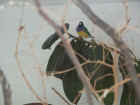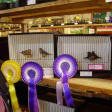|
BREEDS
& THEIR NEEDS
Gouldian
Finches
This information was
provided by Molly and John Eldridge, Club Members from Scotland.
Molly has bred Gouldians, Zebras and Bengalese for many years.
She has Won and been well
placed in many prestigious Shows
with her Bengalese, Zebras & Gouldian Finches
both in Scotland and England, so is an expert in her own right.
 |
 |

|

|
 
|
|
Bengalese
+ Gouldian + zebras
|
Some of
the above Photos are Thumbnails - click to enlarge - click "Back to return to
this page"
THE BREED
- A brightly coloured Australian Finch, which is produced in a multitude of
different colour variations.
- It originates from the Hot dry areas of Australia.
- It is very quiet and sociable and will mix in an Aviary with other similar
sized, quiet finches.
- Size: approx 4" - 10cm.
- Becos of it's ancestry it does require Heated accommodation, which must be
kept to an average of 75 deg. F
- During the Summer months there
may be approx. 3 month period where
you could put these lovely little finches into an outside Aviary - as long
as you ensure there is free access to a warm shelter.
- They are mainly housed in indoor Aviaries or Cages (3ft long 12" wide
and 15" high minimum)
- Never put in and Aviary with or in an Aviary next to Cockatiels, Lovebirds or Ringnecks or other
Parrot-like species etc. (unless there is a
double mesh separated
by at least 1" gap)
- Lovebirds esp. have been known to nip the legs clean off smaller
finch-type birds.
COLOURS
- Blues : Lilac & Blue :
Yellow & Lilac : Black / Red (light & Dark) /Orange
Heads
- You can mix the colours when breeding.
SEXING
- When not in Breeding condition the HEN has black
markings above and at the tip of her beak.
- When in Breeding condition the HEN has a fully black
beak from Top to Tip.
- The cock Bird when ready to breed :
"Dances" on the Branches and displays.
- The cock Bird also has a RED TIP to his beak when in
Breeding condition.
- They become sexually mature around 1 year old.
- They go thru. their first Juvenile moult at approx.
6 months.
- They moult again 6 months later, so it is after this
2nd moult that they are considered ready to breed.
- They live approx. 5 - 6 years.
BREEDING
- It is best to breed them in cages.
- Put the Nestboxes onto the outside of the
cage.
- The Nest box
(approx.
6" x 4") is
shaped a bit like a Luton over the cab of a Lorry, with the hole
on the side of the "Luton" so that they can go into the
hole and onto a small platform before dropping into the main
Nest box.
- As with the Bengalese, you give them a small 2"
wad of Coconut Fibre, which they pull to pieces and make into a ball-shaped
Nest, similar to a Jenny Wren's. They also use their own down feathers to
line the nest.
- If you have the lid of the nest-box hinged, you can
discreetly check on the contents, when the birds are out of the Nest box.
- They mate and bond for life.
- However, if you find that the Hen consistently lays
infertile Eggs, you can split them up and re-pair them
BUT THEY MUST BE
WITHIN SIGHT AND SOUND OF EACH OTHER AT ALL TIMES, otherwise they won't
settle and won't think of breeding with another partner.
- They lay
5 - 7 eggs
- INCUBATION:
14 Days from the last Egg being laid
(same
as the Bengalese)
This is so that all the chicks hatch approx.
together.
- FLEDGE:
approx. 20 days
they come out of the nest.
- RING: 10 days (closed rings) Plastic
split rings any time after 10days to adulthood.
- Closed RING SIZE:
C
- Split plastic
Ring size:
XF
- They stay with their parents for another 3
months.
- If the Hen goes back to nest the father keeps
feeding the Chicks until they become independent.
- They are often used, not to best advantage of the
hens' health, as BREEDING MACHINES!!
- By this I mean that they can lay a
clutch of Eggs, which are removed and put under a surrogate
Bengalese mum
and then the Gouldian Hen will lay again and so on, thus depleting her
calcium reserves etc. if done too often.
- It is important when breeding that they have
FREE
ACCESS to CHARCOAL (essential!)
+ GRIT & CUTTLEFISH.
- EMP Eggfood lightly moistened, is essential
to feed when chicks in the Nest. Feed with added supplementation
(Daily
Essentials 3) as required (follow
directions on supplement tubs)
DO NOT OVER-SUPPLEMENT!
- Add Mealworms to their diet (poss in the EMP
Eggfood) when Breeding for the extra Protein.
- Protein levels are upped just prior to and during
Breeding.
MOULTING
- The worst times for the Youngsters after they have
left the security of the Nest and comfort of their parents is when they go
thru. their first moult.
- It is essential that they are fed correctly and the
Temp. is a min. of 75deg F.
- They need supplementation during the moult.
Daily Essentials 3 added to soft food is ideal.
FEEDING
- Foreign Finch + Budgie seed + Plain Canary Seed +
millet sprays.
- They don't really like Fruit & Veg (poss becos
they come from the Hot, arid area of Australia)
- FRESH WATER must be freely available at all times.
AIR SAC MITES
- Gouldians are prone to Air Sac Mites.
- SYMPTOMS:
The bird sits fluffed up
looking unhappy and it's beak gapes.
- TREATMENT:
Some Experts advocate giving
MILK
for the bird to drink.
Alternatively, you could get
PANOMEC
(an ivermectin-based liquid)
off your VET.
You administer this by blowing the feathers apart at the back
of the neck, where the bird can't reach when it preens and putting
ONE
DROP of the liquid via a dropper provided with the bottle. This
acts systemically (i.e. it is absorbed thru. the skin - both the birds and
yours, if you are not careful)!! It's a bit like using
"Frontline" on your Dog or Cat.
It is essential, therefore that you wear RUBBER GLOVES to do this!
- PANOMEC
kills internal worms and external
parasites, such as mites and lice etc.
BATHING
- Once again becos. they come from an area that is hot
and dry they tend NOT to BATHE.
- They do like a light, warm rain shower during the
hotter summer months.
- They DO NOT like DAMP and the COLD.
**It must be noted that even though Gouldians
are a delight to own they ARE
NOT a BEGINNERS bird and do
require specialised knowledge and care to ensure they are kept in the best of
health both mentally and bodily.
Beginners would be better to start and gain
knowledge and experience with Bengalese or Zebra Finches.
|





